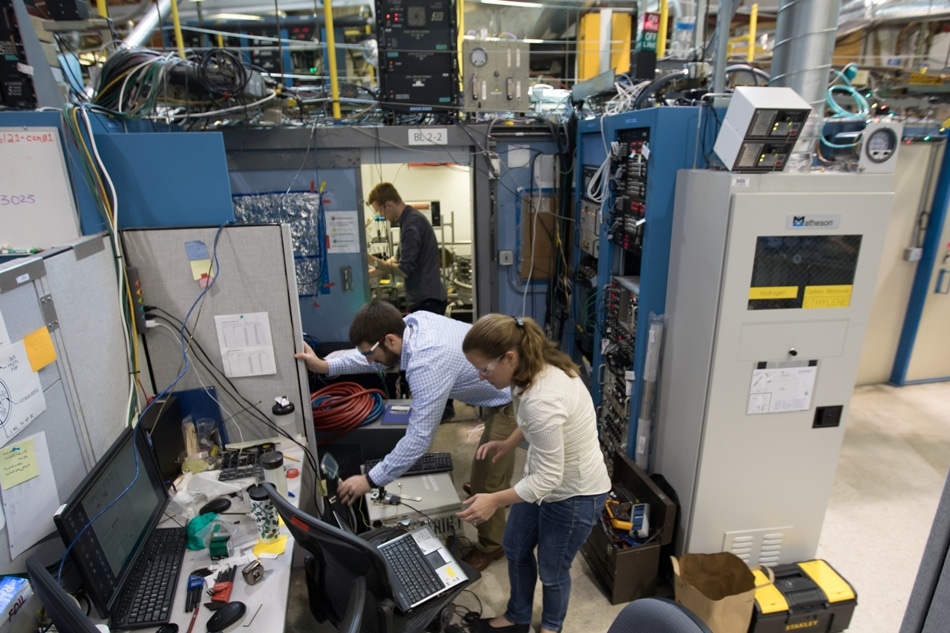Jan 31 2018
Researchers from the Department of Energy’s SLAC National Accelerator Laboratory have used X-ray light to monitor and understand the formation of defects in the finished product, during the process of fabricating metal parts through three-dimensional (3D) printing; to find out ways to prevent such defects. The goal of the research is to assist manufacturers in the on-the-spot production of highly reliable parts - on a ship or plane, in a factory or remotely in space - and perform it in a highly effective manner, without the need for storing more extra parts.
 SLAC staff scientist Johanna Nelson Weker, front, leads a study on metal 3-D printing at SLAC’s Stanford Synchrotron Radiation Lightsource with researchers Andrew Kiss and Nick Calta, back. CREDIT: Dawn Harmer/SLAC.
SLAC staff scientist Johanna Nelson Weker, front, leads a study on metal 3-D printing at SLAC’s Stanford Synchrotron Radiation Lightsource with researchers Andrew Kiss and Nick Calta, back. CREDIT: Dawn Harmer/SLAC.
The study is being carried out at the Stanford Synchrotron Radiation Lightsource (SSRL), in cooperation with researchers from the DOE’s Lawrence Livermore National Laboratory and Ames Laboratory.
The 3D printing method, called additive manufacturing, produces solid, 3D objects based on a computer model through the layer-by-layer addition of material. Although the application of polymers and plastics in 3D printing has progressed rapidly, 3D printing using metals for industrial purposes has been difficult to perform.
With 3-D printing, you can make parts with very complex geometries that are not accessible for casting like regular metal parts. Theoretically, it can be a quick turnaround - simply design, send, print from a remote location. But we’re not there yet. We still need to figure out all of the parameters involved in making solid, strong parts.
Johanna Nelson Weker, SLAC Staff Scientist
Advancement of metal 3D printing is being carried out to create highly specialized parts for aircraft, healthcare, aerospace and automotive industries. At present, companies such as General Electric and Boeing that fabricate metal parts by using 3D printing, have to put the 3D printer and each part through vigorous quality checks. However, according to the scientists, if the method can be understood further so that it accurately prints parts without any defect, the necessity for investigating will decrease, thereby reducing the manufacturing cost.
Pits Among the Layers
The process of metal 3D printing involves distributing a thin layer of powdered metal (e.g. aluminum alloys, titanium alloys, copper or steel) on a platform and selectively melting it by using a high-powered laser beam. Subsequently, the platform is lowered, and another layer of the metal powder is distributed. This process is repeated till the object is completely formed.
In many cases, the process leads to the formation of pits (i.e. weak spots) upon uneven cooling and hardening of metal during the layer build-up. As part of the SLAC X-ray experiments, researchers investigated each aspect of the process: the type of metal used, the extent of laser heat, the heating and cooling speed of the metal, in order to zero in on the optimal combination for getting rid of pits, manipulating the microstructure and producing robust metal parts.
“We are providing the fundamental physics research that will help us identify which aspects of metal 3-D printing are important,” stated Chris Tassone, a staff scientist in SSRL’s Materials Science Division. According to him, only practical information can ultimately result in the writing of instructions for 3D printer laser settings that can be adopted by manufacturers to manufacture robust parts.
To date, scientists observed the addition of layers to form a part from above. As they could not observe below the surface of the metal, they didn’t know the exact depth of the laser melting when each layer was applied. They attempted to image the added layers by using thermal radiation, that is, heat. However, it did not provide them with adequate information on the reason for the formation of the weak spots. By contrast, X-rays prove to be an excellent tool for the scientists to observe and record the happenings inside the part while it is formed.
The researchers have adopted two X-ray techniques to observe what happens in the process of metal 3D printing. They used one kind of X-ray light to develop micron-resolution images of the events when the metal layers are built. The second technique involves bouncing of X-rays off the atoms in the material to investigate its atomic structure when it transforms from solid to liquid and then again to a solid form as part of the melting and cooling process.
So far, the team has investigated lasers striking the metal powder layers; however, they also aim to analyze another strategy known as “directed energy deposition.” During this process, a laser beam strikes and melts wire or metal powder when it is distributed, enabling the formation of highly complex geometric forms. This type of 3D printing is specifically helpful in carrying out repairs.
They also aim to integrate a high-speed camera into the experimental framework so that they can gather video and photographs of the manufacturing process and compare the observation with the X-ray data.
According to Nelson Weker, this will be highly helpful for manufacturers and other scientists using cameras to see the process but who cannot access an X-ray synchrotron: “We want people to be able to connect what they see on their cameras with what we are measuring here so they can infer what’s happening below the surface of the growing metal material. We want to put meaning to those signatures.”
Kevin Stone, Anthony Fong, Andrew Kiss, and Vivek Thampy are the other scientists who were part of the metal 3D printing project. SSRL is a DOE Office of Science user facility. The DOE Office of Energy Efficiency and Renewable Energy’s Advanced Manufacturing Office funded the study.